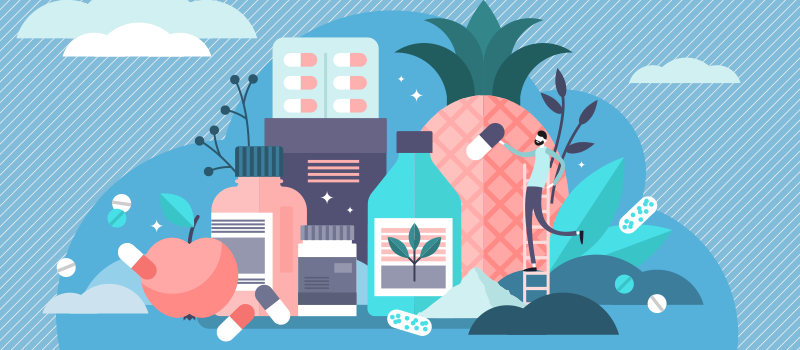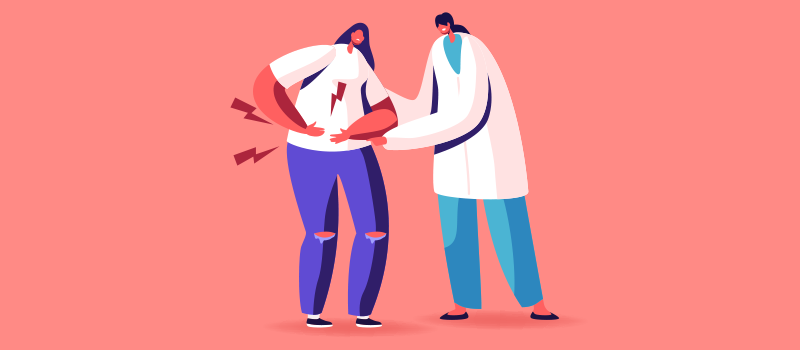What’s the Buzz
The Bee Healthy Blog
How to Rebuild Your Microbiome After Antibiotics

Antibiotics are medications that are prescribed to treat bacterial infections such as strep throat, UTIs, bacterial pneumonia, meningitis, and more. They work by making it hard for bacteria to grow and multiply. Some antibiotics are broad spectrum, i.e., they act against a wide variety of bacteria, while others are more specific. Antibiotics are life-saving drugs in people with serious bacterial infections.
However, like all medicines, antibiotics can have side effects. One well-known adverse effect of taking antibiotics is that they dramatically alter the gut microbiome. This is the reason you can develop symptoms such as antibiotic-associated diarrhea, nausea, and vomiting.
Continue reading to learn more about the effects a course of antibiotics can have on gut health and what you can do to restore healthy gut flora.
What is the gut microbiome?
Trillions of microorganisms live inside the human gut, including bacteria, viruses, fungi, and other living organisms that are together called the gut microbiome. Of the hundreds of species of bacteria that call the human gut home, some are pathogenic (disease-causing) and some are beneficial bacteria. The good bacteria not only help in digesting food but also keep the bad bacteria in check.
When you are treated for a bacterial infection, the antibiotics kill harmful gut bacteria, but they also kill some of the beneficial gut bacteria, thereby affecting your gut health. This can affect your whole body. There is strong evidence that a healthy gut is closely linked to overall health. Research has shown that several diseases, including cancer, autoimmune disorders, autism spectrum disorder, and multiple sclerosis are influenced by the gut microbiota. Studies have also shown that excessive antibiotic use, especially early in life, can disrupt gut health and lead to lifelong problems with obesity.
Taking a course of antibiotics is sometimes necessary to treat a bacterial infection. However, overuse of antibiotics can lead to long-term changes in the microbial diversity of the digestive tract. For this reason, it is important to always take antibiotics as prescribed. Not all infections require antibiotic treatment (antibiotics do not treat viral infections and some bacterial infections are self-limited and require no treatment). If you do take antibiotics, there are several things you can do to restore gut flora after antibiotic treatment.
Can you reset your microbiome?
Yes, it is possible to restore your gut to a healthy state after taking antibiotics. A healthy diet and certain supplements can help re-establish healthy gut flora and prevent the common side effects of antibiotic use such as antibiotic-associated diarrhea.
How long does it take to restore gut flora after antibiotics?
It can take several weeks to months to restore gut health after antibiotics. Research shows that most healthy gut bacteria return to normal levels roughly 2 months after antibiotic treatment. However, studies have also found that some healthy bacteria are missing even 6 months after taking antibiotics.
The gut microbiota is a delicate ecosystem and even a few missing beneficial gut bacteria can throw it out of balance. There is no fixed timeline for a return to gut health after a course of antibiotics. It’s possible that the gut flora may never return to normal. But this doesn’t mean you cannot take steps to maximize gut health by increasing the microbial diversity in your digestive tract.
What should I eat to restore good bacteria after a course of antibiotics?
Here are some foods that can help restore gut flora after antibiotics:
Probiotics
Probiotics are foods or supplements that contain live microorganisms, most commonly Lactobacillus and Bifidobacterium (which are healthy bacteria) and Saccharomyces boulardii (which is a type of yeast). Taking probiotics helps the gut microbiome return to a healthy state after it has been disturbed. Probiotics also have a positive influence on the immune system of the body. The timing of your probiotic intake is important - doctors advise that you take probiotics at least 2 hours before your antibiotic dose.
Prebiotics (high-fiber foods)
Prebiotic foods support beneficial microbes in the human gut (they are food for beneficial bacteria). High-fiber foods are prebiotics. A diet rich in fiber can therefore help restore gut flora after antibiotics by promoting the growth of good bacteria. Eating high-fiber foods like whole grains, lentils, fruits, and vegetables (beans, peas, broccoli, artichokes, apples, bananas), nuts and seeds not only stimulates the growth of healthy bacteria in the gut but also slows the growth of harmful bacteria. Besides natural prebiotic foods, prebiotics are also available as dietary supplements.
Fermented foods
Fermented foods like yogurt, cheese, cider, sauerkraut, kombucha, and kimchi contain beneficial bacteria that can help restore a healthy gut after antibiotic use. Some fermented foods like yogurts are supplemented with probiotics (healthy gut bacteria) and can be especially helpful in restoring the gut microbiota and reducing antibiotic side effects.
Collagen-rich foods
Beneficial bacteria help to keep the intestinal gut lining intact. If the lining is not healthy, harmful bacteria can colonize the area and poke holes in the gut lining, allowing food particles to leak out of the digestive tract and cause problems. Collagen is an essential protein in the body that supports the gut lining and connective tissues. Eating collagen-rich foods like bone broth, chicken, fish, shellfish, egg whites, and citrus and tropical fruits can help strengthen the intestinal walls. Vitamin C is required to make collagen, so it’s a good idea to boost vitamin C intake if you’re trying to restore gut flora after antibiotics.
How else can I replenish my gut bacteria?
What you eat has a big impact on your gut microbiota. But to give healthy gut bacteria their best chance, there are some other things you can do as well.
To restore gut flora after antibiotics, make efforts to keep mental stress under control. Research has shown that emotions like sadness and elation can trigger changes in the gut (if you’ve ever felt butterflies in your stomach or felt nauseous before a big presentation, you’ll know what we mean). Scientists call it the gut-brain axis, a connection that can potentially affect gut flora.
Last but not least, sleep quality has an impact on gut health. Poor sleep quality or sleep deprivation can negatively impact the gut microbiota. This effect is also believed to be mediated via the gut-brain axis. Lack of sleep can trigger sugar cravings, and sugar feeds bad bacteria in the gut.
The bottom line is that taking antibiotics is not entirely avoidable and the negative impact of antibiotics on the gut microbiota is well known. But by eating a healthy diet including whole foods, fruits and vegetables, and fermented foods; taking probiotics and prebiotics; keeping stress under control; and getting enough good-quality sleep, you can restore a healthy gut flora after antibiotics, boost your immune system, and enhance your overall health.
References:
- https://medlineplus.gov/antibiotics.html
- https://www.nature.com/articles/d41586-020-00194-2
- https://www.ncbi.nlm.nih.gov/pmc/articles/PMC4487629/
- https://www.ncbi.nlm.nih.gov/pmc/articles/PMC4831151/
- https://www.sciencedaily.com/releases/2018/10/181023110545.htm
- https://www.nccih.nih.gov/health/probiotics-what-you-need-to-know
- https://www.health.harvard.edu/diseases-and-conditions/the-gut-brain-connection











SOCIAL